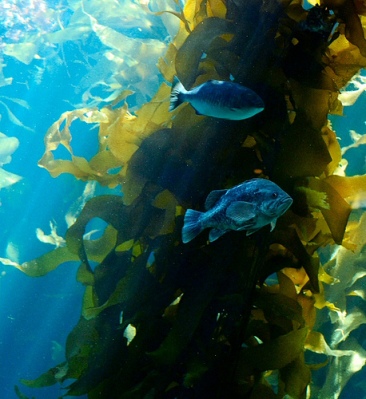Yes, you read that right. Climate Change. Last week, I read about a new study by two UC Santa Cruz researchers that suggests that sea otters undoubtedly influence the carbon cycle, CO2 storage, by limiting sea urchin populations which allows kelp forests to thrive. The paper was published online in Frontiers in Ecology and the Environment by lead authors UC Santa Cruz professors Chris Wilmers and James Estes. The results of the study indicate that kelp absorbs as much as 12 times the amount of CO2 from the atmosphere with a thriving sea otter population.
The UCSC researchers and their co-authors combined 40 years of data on otters and kelp bloom from Vancouver Island to the western edge of Alaska’s Aleutian Islands. By comparing kelp density with otters and kelp density without otters, they found that sea otters have a positive indirect effect on kelp biomass by keeping sea urchin populations in check. Without sea otters, sea urchin populations explode and decimate large areas of kelp beds resulting in urchin barrens.
Even though kelp is particularly efficient at sequestering CO2 from the atmosphere, scientists have assumed that kelp forests weren’t a significant factor in reduction of the amount of carbon in the atmosphere. They were surprised to discover that the effect of sea otter’s maintaining healthy kelp forests represents a 4.4- to 8.7 megaton increase in carbon storage. The economic value of the stored carbon on the European Carbon Exchange in 2012 prices is estimated to be between $205 to $408 million US dollars.
Given the global scale of climate change, Jeffrey Dukes of the Purdue Climate Change research Center stated that the impact of sea otters is “relatively inconsequential in terms of the big picture of climate change, [but it’s] an interesting study identifying how dramatically a predator can alter the cycling of carbon in an ecosystem” (National Geographic News, Kate Andries).
The researchers acknowledge that otters only play a minor role but their study illustrates that animals worldwide can influence the carbon cycle and might actually have a large impact on reduction of CO2 in the atmosphere.
It is well known that sea otters play a significant role in the nearshore marine ecosystem. As a keystone species[i] they maintain local biodiversity by controlling populations of other species, such as sea urchins, that would otherwise dominate and alter the nearshore environment. A giant kelp forest is an ecosystem unto itself hosting invertebrates, fish, marine mammals, and birds from their holdfasts to the surface mats of kelp fronds. The array of habitats on the kelp itself may support thousands of invertebrate individuals, including polychaetes, amphipods, decapods, and ophiuroids and provides nurseries for fish and other species (NOAA National Marine Sanctuaries).
The results of this study broadly shows how important maintaining ecological/ecosystem balance at the local level is to the global ecosystem we live in. Everything is connected. Increased protection for sea otters results in increasing kelp biomass and productivity, a healthier nearshore ecosystem, and a positive impact on our atmosphere and our planet.
[i] A keystone species is one whose impacts on its community or ecosystem are large and greater than would be expected from its relative abundance or total biomass.


